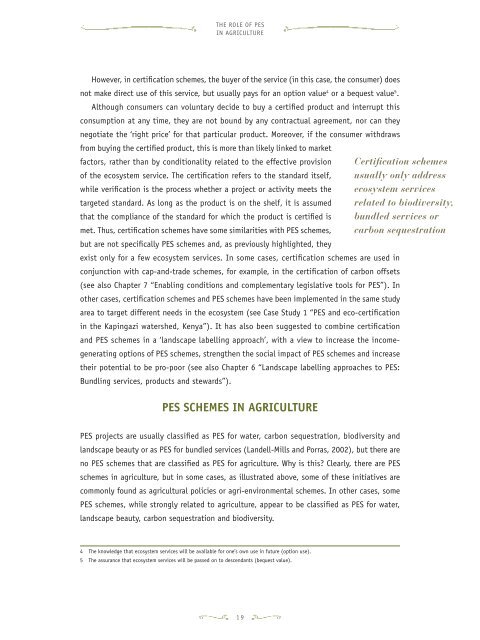agriculture and ecosystem services - Serena
agriculture and ecosystem services - Serena
agriculture and ecosystem services - Serena
Create successful ePaper yourself
Turn your PDF publications into a flip-book with our unique Google optimized e-Paper software.
The role of PESin <strong>agriculture</strong>However, in certification schemes, the buyer of the service (in this case, the consumer) doesnot make direct use of this service, but usually pays for an option value 4 or a bequest value 5 .Although consumers can voluntary decide to buy a certified product <strong>and</strong> interrupt thisconsumption at any time, they are not bound by any contractual agreement, nor can theynegotiate the ‘right price’ for that particular product. Moreover, if the consumer withdrawsfrom buying the certified product, this is more than likely linked to marketfactors, rather than by conditionality related to the effective provision Certification schemesof the <strong>ecosystem</strong> service. The certification refers to the st<strong>and</strong>ard itself, usually only addresswhile verification is the process whether a project or activity meets the <strong>ecosystem</strong> <strong>services</strong>targeted st<strong>and</strong>ard. As long as the product is on the shelf, it is assumed related to biodiversity,that the compliance of the st<strong>and</strong>ard for which the product is certified is bundled <strong>services</strong> ormet. Thus, certification schemes have some similarities with PES schemes, carbon sequestrationbut are not specifically PES schemes <strong>and</strong>, as previously highlighted, theyexist only for a few <strong>ecosystem</strong> <strong>services</strong>. In some cases, certification schemes are used inconjunction with cap-<strong>and</strong>-trade schemes, for example, in the certification of carbon offsets(see also Chapter 7 “Enabling conditions <strong>and</strong> complementary legislative tools for PES”). Inother cases, certification schemes <strong>and</strong> PES schemes have been implemented in the same studyarea to target different needs in the <strong>ecosystem</strong> (see Case Study 1 “PES <strong>and</strong> eco-certificationin the Kapingazi watershed, Kenya”). It has also been suggested to combine certification<strong>and</strong> PES schemes in a ‘l<strong>and</strong>scape labelling approach’, with a view to increase the incomegeneratingoptions of PES schemes, strengthen the social impact of PES schemes <strong>and</strong> increasetheir potential to be pro-poor (see also Chapter 6 “L<strong>and</strong>scape labelling approaches to PES:Bundling <strong>services</strong>, products <strong>and</strong> stewards”).PES schemes in <strong>agriculture</strong>PES projects are usually classified as PES for water, carbon sequestration, biodiversity <strong>and</strong>l<strong>and</strong>scape beauty or as PES for bundled <strong>services</strong> (L<strong>and</strong>ell-Mills <strong>and</strong> Porras, 2002), but there areno PES schemes that are classified as PES for <strong>agriculture</strong>. Why is this? Clearly, there are PESschemes in <strong>agriculture</strong>, but in some cases, as illustrated above, some of these initiatives arecommonly found as agricultural policies or agri-environmental schemes. In other cases, somePES schemes, while strongly related to <strong>agriculture</strong>, appear to be classified as PES for water,l<strong>and</strong>scape beauty, carbon sequestration <strong>and</strong> biodiversity.4 The knowledge that <strong>ecosystem</strong> <strong>services</strong> will be available for one’s own use in future (option use).5 The assurance that <strong>ecosystem</strong> <strong>services</strong> will be passed on to descendants (bequest value).19


